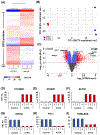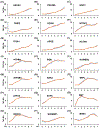Temporal Proteomic Profiling of SH-SY5Y Differentiation with Retinoic Acid Using FAIMS and Real-Time Searching
- PMID: 33054241
- PMCID: PMC8210949
- DOI: 10.1021/acs.jproteome.0c00614
Temporal Proteomic Profiling of SH-SY5Y Differentiation with Retinoic Acid Using FAIMS and Real-Time Searching
Abstract
The SH-SY5Y cell line is often used as a surrogate for neurons in cell-based studies. This cell line is frequently differentiated with all-trans retinoic acid (ATRA) over a 7-day period, which confers neuron-like properties to the cells. However, no analysis of proteome remodeling has followed the progress of this transition. Here, we quantitatively profiled over 9400 proteins across a 7-day treatment with retinoic acid using state-of-the-art mass spectrometry-based proteomics technologies, including FAIMS, real-time database searching, and TMTpro16 sample multiplexing. Gene ontology analysis revealed that categories with the highest increases in protein abundance were related to the plasma membrane/extracellular space. To showcase our data set, we surveyed the protein abundance profiles linked to neurofilament bundle assembly, neuron projections, and neuronal cell body formation. These proteins exhibited increases in abundance level, yet we observed multiple patterns among the queried proteins. The data presented represent a rich resource for investigating temporal protein abundance changes in SH-SY5Y cells differentiated with retinoic acid. Moreover, the sample preparation and data acquisition strategies used here can be readily applied to any analogous cell line differentiation analysis.
Keywords: ATRA; SPS-MS3; TMTpro; eclipse; multinotch; retinoic acid.
Figures




References
-
- Zhang M; Zhang YQ; Wei XZ; Lee C; Huo DS; Wang H; Zhao ZY Differentially expressed long-chain noncoding RNAs in human neuroblastoma cell line (SH-SY5Y): Alzheimer’s disease cell model. J. Toxicol. Environ. Health, Part A 2019, 82, 1052–1060. - PubMed
-
- de Medeiros LM; De Bastiani MA; Rico EP; Schonhofen P; Pfaffenseller B; Wollenhaupt-Aguiar B; Grun L; Barbe-Tuana F; Zimmer ER; Castro MAA; Parsons RB; Klamt F Cholinergic Differentiation of Human Neuroblastoma SH-SY5Y Cell Line and Its Potential Use as an In vitro Model for Alzheimer’s Disease Studies. Mol. Neurobiol 2019, 56, 7355–7367. - PubMed
-
- Azzolin VF; Barbisan F; Lenz LS; Teixeira CF; Fortuna M; Duarte T; Duarte M; da Cruz IBM Effects of Pyridostigmine bromide on SH-SY5Y cells: An in vitro neuroblastoma neurotoxicity model. Mutat. Res., Genet. Toxicol. Environ. Mutagen 2017, 823, 1–10. - PubMed
-
- Xie HR; Hu LS; Li GY SH-SY5Y human neuroblastoma cell line: in vitro cell model of dopaminergic neurons in Parkinson’s disease. Chin. Med. J 2010, 123, 1086–1092. - PubMed
Publication types
MeSH terms
Substances
Grants and funding
LinkOut - more resources
Full Text Sources

